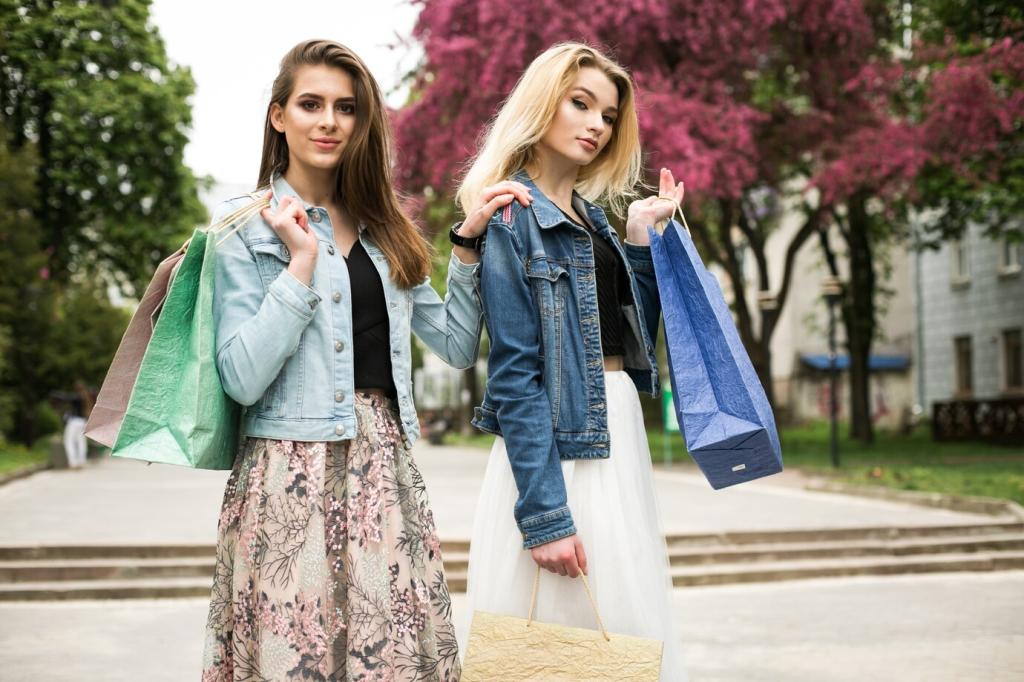
Innovative Eco-Friendly Textiles in Fashion
Discover how the fashion industry is transforming by embracing innovative eco-friendly textiles. As climate concerns rise and consumers seek responsible choices, fashion brands are pioneering sustainable methods and materials. This revolution in textiles champions both environmental health and cutting-edge style, ensuring that creativity thrives while protecting the planet. Explore the dynamic landscape of sustainable textiles and uncover how responsible fashion is shaping the future.
From Niche to Mainstream
Initially, eco-friendly textiles were exclusive to a handful of ethical brands operating on the fringes of the fashion world. Over the past decade, however, sustainable materials and methods have rapidly entered mainstream consciousness. Today, both independent labels and global giants showcase extensive collections made of recycled fibers or plant-based fabrics, reflecting broad societal shifts towards environmental awareness. As fashion’s role in resource depletion became indisputable, stakeholders from designers to consumers propelled this change, transforming sustainability into a key industry expectation rather than a mere trend.
Consumer Awareness and Expectations
Rising consumer awareness about climate change, waste, and the true cost of fast fashion has fostered a groundswell of demand for transparency and responsibility. Shoppers increasingly research the origins of their clothing, seeking certifications, and preferring brands that disclose their supply chains. This cultural momentum has pushed brands to move beyond marketing buzzwords and genuinely adopt innovative, sustainable textiles. For companies, this not only satisfies regulatory requirements but also builds brand loyalty among ethically conscious consumers who prioritize values alongside style.
Industry Collaboration and Innovation
Recognizing that change requires collective effort, different sectors of the fashion industry are collaborating more than ever before. Partnerships between textile innovators, environmental scientists, and major fashion houses are yielding exciting breakthroughs, from bio-fabricated yarns to closed-loop recycling systems. These collaborations are essential for overcoming technical hurdles and bringing eco-friendly solutions to scale. The shared focus on sustainable innovation is transforming the entire fashion ecosystem, setting a new standard for creativity, quality, and environmental stewardship.
Plant-Based Revolution: Fabrics from Nature
The Rise of Bamboo and Hemp
Bamboo and hemp fabrics are making waves as sustainable fashion powerhouses due to their rapid growth and minimal need for chemicals or water. Unlike conventional cotton—which depletes soil and consumes vast resources—both bamboo and hemp thrive in varied climates, replenish soil fertility, and naturally deter pests. The resulting textiles are soft, breathable, and durable, making them ideal for daily wear. With minimal processing, these fibers can be transformed into luxurious, eco-friendly garments that perform exceptionally well and convey an understated sense of elegance.
Piñatex: Pineapple Leather
An outstanding innovation in plant-based textiles is Piñatex, a durable material crafted from pineapple leaf fibers—agricultural waste that would otherwise be discarded. Developed as an alternative to animal-derived leather, Piñatex provides fashion designers with a supple, versatile textile perfect for shoes, bags, and outerwear. Its production process emits fewer greenhouse gases compared to traditional leather tanning and offers farmers a way to monetize crop residues. Piñatex has quickly gained recognition as a luxurious and sustainable choice, sparking conversations about circularity and resourcefulness.
Lyocell: The Eco-Friendly Cellulosic
Lyocell, often marketed as TENCEL™, is a cellulosic fiber derived primarily from sustainably harvested wood, such as eucalyptus or beech. Distinguished by its environmentally responsible closed-loop manufacturing process, Lyocell production recovers and recycles over 99% of solvents used. This produces a silky-smooth, moisture-wicking textile that’s gentle on skin and kind to the planet. Its versatility across apparel—from activewear to elegant dresses—has made Lyocell a flagship example of plant-based fashion innovation, catering to the eco-conscious without sacrificing comfort or style.
Regenerative and Organic Fiber Innovations
01
Regenerative cotton is grown using farming techniques that prioritize soil health, biodiversity, and the restoration of natural cycles. These methods go beyond organic, capturing carbon in the soil, promoting water retention, and reducing the need for synthetic fertilizers and pesticides. Compared to conventional cotton farming, which is notorious for its water and chemical use, regenerative cotton offers a vision of fashion with a healing touch. Garments produced from this cotton support communities, preserve habitats, and tell a story of responsible stewardship.
02
Organic wool sets itself apart by originating from flocks raised according to strict welfare and land management standards. Unlike industrial sheep farming, which is often linked to overgrazing and soil erosion, organic practices help rebuild pastureland, encourage local biodiversity, and eliminate synthetic chemicals from the production process. The result is a fiber that’s naturally insulating, biodegradable, and less likely to irritate the skin. Organic wool offers a premium feel, connecting wearers to a supply chain that values both animal and ecological well-being.
03
Flax, the plant used to produce linen, is naturally resilient and thrives with minimal intervention, making it a prime candidate for regenerative agriculture. Forward-thinking producers combine ancient cultivation methods with modern scientific knowledge to restore soil vitality and enhance carbon sequestration. The entire flax plant is utilized, resulting in little to no waste. Linen derived from regenerative flax is cooling, absorbent, and incredibly durable, offering both a timeless look and meaningful environmental impact. Advocates for linen celebrate it as a symbol of how tradition and innovation can merge for the planet’s benefit.

Recycled Polyester: Plastics Reborn
Recycled polyester, often made from post-consumer plastic bottles, has quickly become a popular alternative to virgin petrochemical-based fibers. The process involves collecting, cleaning, and melting plastic waste to spin new threads, which are then woven into textiles. This significantly curbs the use of fossil fuels and prevents plastics from polluting ecosystems. While concerns about microplastics persist, advances in filtering and recycling technology continue to improve the eco profile of recycled polyesters, securing their place in activewear, accessories, and even high fashion.
Upcycled Cotton: Reducing Textile Waste
Upcycled cotton takes pre- and post-consumer waste—such as offcuts from factories or discarded apparel—and mechanically processes it into new yarns and fabrics. Unlike conventional recycling, which often weakens fibers, modern techniques blend upcycled fibers with a small percentage of new cotton, resulting in strong and versatile textiles. This process drastically reduces water and chemical consumption compared to growing new cotton crops. Upcycled cotton allows designers to create unique, low-impact products while illustrating the virtues of circular fashion thinking.
Regenerated Nylon: From Waste to Wearable
Regenerated nylon, such as ECONYL®, transforms ocean plastics, fishing nets, and industrial waste into high-quality durable fibers. These products are chemically broken down and rebuilt into nylon of equal strength and quality to its virgin counterpart. Swimwear, sportswear, and luxury brands are drawn to regenerated nylon not only for its performance but for its powerful narrative: each garment helps remove harmful waste from the environment. By embracing regenerated nylon, the fashion industry signals a commitment to restorative material cycles and ocean health.
Biotechnology in Textiles
Lab-grown leather, produced using cultivated animal cells or engineered proteins, offers a cruelty-free and environmentally sound alternative to traditional and even plant-based leathers. Using minimal resources, these materials can be made to mimic the texture, appearance, and durability of animal hides without the ethical concerns or chemical-intensive tanning processes. Brands experimenting with lab-cultivated leather aim for products that boast the luxury and longevity consumers expect, signaling a seismic shift away from factory-farmed leather at scale.
Synthetic dyes are notorious for water pollution and worker hazards. Microbial dyeing harnesses genetically engineered bacteria or fungi to produce pigments with a fraction of the environmental cost. This emerging field enables the creation of vivid colors without relying on toxic chemicals, excessive water use, or hazardous waste. Designers working with microbial dyes not only cut down on pollution but also open creative avenues for unique patterns and colors derived directly from nature’s own processes.
Through innovative biotechnological techniques, scientists are now able to produce protein-based fibers, such as silk, in a laboratory setting. By replicating the genetic building blocks of spider silk or silkworm cocoons in yeast or bacteria, these textiles combine the strength, softness, and flexibility of natural silk with a vegan and scalable production process. The result is a new generation of high-performance, low-impact fibers that blend ancient inspiration with state-of-the-art technology, paving the way for cruelty-free luxury fashion.
Water-Saving Technologies in Textile Production
Traditional textile finishing often involves heavy water usage for washing, dyeing, and treating fabrics. Dry processing, including innovative techniques like airjet and laser treatments, offers a waterless alternative. Particularly prevalent in denim manufacturing, these processes deliver unique finishes, such as fading or distressing, without using gallons of water or producing chemical-heavy effluent. Dry processing not only conserves water but also minimizes pollution, helping brands meet stricter environmental regulations and satisfy eco-conscious consumers.
Previous
Next

Innovative Business Models for Sustainable Fashion
Fashion rental platforms challenge the traditional ownership paradigm, allowing consumers to access high-quality garments without the commitment of purchase. This model significantly cuts down on clothing waste and the need for new textile production. By leveraging eco-friendly textiles within their offering, rental companies ensure that even the most transient fashion experience is mindful of its environmental implications. Alongside convenience and cost savings for consumers, the rise of fashion rental demonstrates a broader cultural shift toward access over accumulation.
